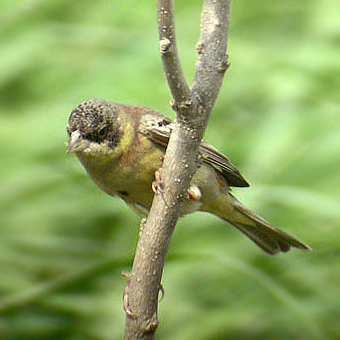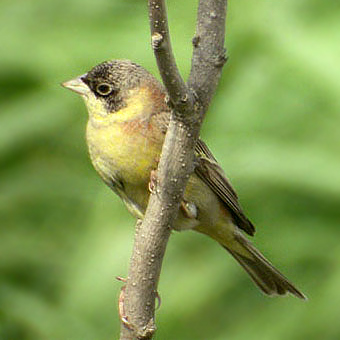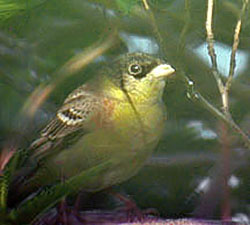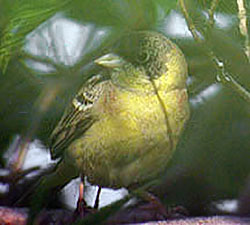Nial and Charlie Moores
After a few days of mainly sunny and relatively still conditions, May 15th on Eocheong began with four hours of rain from dawn onwards. Small numbers of migrants, including several Yellow-breasted and 3 Japanese Yellow Buntings were grounded: most interesting though was a (first summer?) male Black-headed Bunting, found by NM in a small mixed bunting flock. It was present until the afternoon of the next day (the 16th), but after being inadvertently flushed by two islanders was not seen again.
Proving very elusive (and extraordinarily camera-shy on its first day), this is believed to be only the second record of Black-headed Bunting in Korea - after the first on Gageo Island on November 04 2000 (also found by NM).


Not listed in Lee, Koo, and Park (2000), the Black-headed Bunting breeds from Italy, Bulgaria, and Romania east into Iran and regions south of the Caspian Sea. It winters mainly in cultivated fields in western and central India (Byers, Olsson and Curson, 1995).
According to the same authors the species "seems to have a propensity for overshooting mainly in spring", and has become a near regular vagrant to neighboring Japan, with e.g. eight published records between 1985 and 1988. Though these are mostly in late autumn or winter, they include two May records (Brazil 1991), and have been followed by e.g. 2 on Tsushima in May 1991 (NM: pers obs). There are also several records from e.g Hong Kong and even Sabah (Dymond, 1999).
Although it is possible that this individual migrated in the wrong direction from its wintering grounds, it seems rather more likely, based on the pattern of records in Japan and October records from as far south as Sabah, that it overshot its wintering grounds in the previous autumn, and was now migrating northward with other buntings.

Although this individual can be sexed as a male (based on e.g.the blackness of the head feathers, and the rich tones to the upperparts and breast sides) its aging is more problematical, as current literature appears to be somewhat contradictory.
For example, both Svensson (1992) and Byers et al (1995) state that the moult strategy of the species is highly unusual amongst buntings, and that there should be no difference in the appearance of adult and second calendar year birds in spring. Indeed the Eocheong bird appears closest in many ways to the non-breeding adult male depicted in Byers et al - a plumage typical of autumn birds. One explanation could be that it has started to undertake an exceptionally early moult; another that it is instead a first summer which has not acquired a "full" breeding plumage, similar to e.g. Yellow-breasted Bunting.
Intriguingly, this bird appears rather close in plumage tones and condition to one of the two 1991 Tsushima birds (NM pers obs, and depicted in plate 2, p. 266, in Iozawa et al, 2000) and very close to one photographed in May 1995 in Fishguard, UK. The latter was included in an article in Birding World ( Vol8 No6 1995) written by Richard Millington, who in an email expresses his opinion that though Black-headed Buntings do not have " a first-summer plumage as such...some first-summer individuals are surely % ageable as such if in a suitably retarded plumage" (pers comm 27th May 2003). Perhaps, then, such individuals as the one here are not so unusual?


As always, comments from those with experience of the species are most welcome.
References:
- Byers, Olsson and Curson, 1995. Buntings and Sparrows.
- Millington, R. 1995.Black-headed Buntings in spring 1995, Birding World Vol8 No6.
- Brazil, M. 1991. The Birds of Japan. Helm. London.
- Dymond, N. 1999. Two records of Black-headed Bunting Emberiza melanocephala in Sabah - the first definite occurrences in Malaysia and Borneo. Forktail15 (1999).
- Iozawa, Yamagata and Yoshino. 2000. Wild Birds of Japan, 550. Land birds volume.
- Svensson, L. 1992. Identification Guide to European Passerines, Fourth Edition. Stockholm, Sweden.



